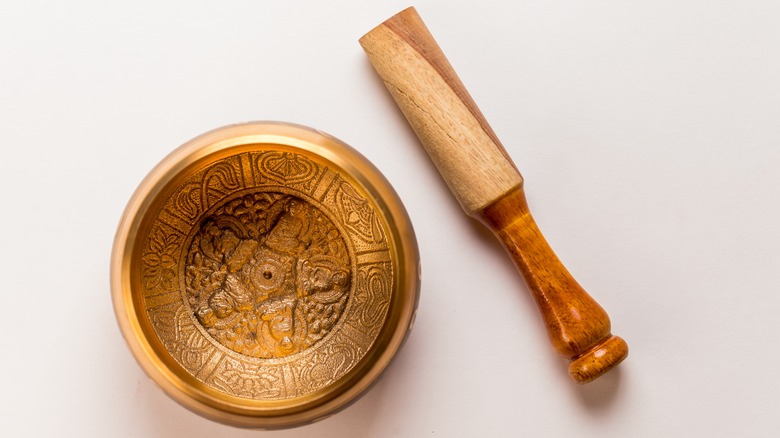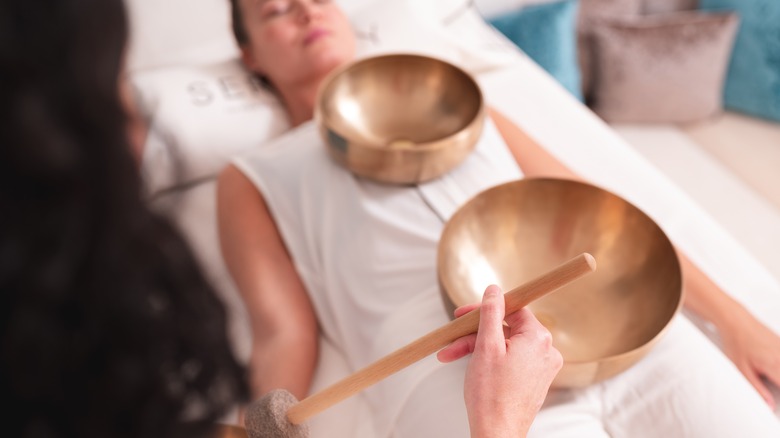Sound Healing: Can It Improve Your Mental Health, Or Is It New Age BS?
Touch, sight, smell, taste, and hearing: These are the core five senses which comprise the human experience if you are a fully able-bodied person. Or, if you're referring to "Mean Girls," there's always the potential to have a sixth sense like you "have ESPN or something."
Taking into account the actual five senses, there are many ways that we use them to make it through day-to-day life, experience the world, and heal when our bodies are in need. Perhaps you utilize massage as a form of touch healing, go to a beautiful spot in nature for sight-based healing, utilize the principles of mindful eating to restore yourself through smell, or make your way through a sleeve of Oreos to heal through taste. Our senses can help us discern the world around us, remain attuned to our bodies, and seek out essential needs for our survival.
When it comes to hearing, sound healing is the latest trendy treatment to make its way into popular discourse. In case you haven't heard about it yet (pun intended), Shape reports that there's a new sound theory with Tibetan origins rising in popularity. Through the use of instruments called "singing bowls," the therapy is purported to "hack your brainwaves" and promote healing.
But determining if it's a legitimate form of healing or just a fictitious narrative that isn't worth buying into is a question that can be answered by taking a deeper look — or a deeper listen, in the spirit of sound — into the components of the healing method and its potential outcomes.
What we hear changes how we live
To say that the things we hear direct the ways we live our lives isn't an extreme assertion to make. Whether it's conversations, TikTok videos, podcasts, streaming shows, or music that we are absorbing, our sense of hearing is crucial to how we feel and process our emotions. The sense of hearing is known to help shift moods and outlooks by eliciting feelings, thoughts, and memories through the use of music — from a centuries-old classical sonata to a recently released pop track. A 2013 study published in Trends in Cognitive Sciences found that sound can change the neurochemistry of our brains, thus resulting in positive effects such as pain reduction, emotional management, reflection, and relaxation of both the body and the mind.
The human ears are constantly working unsung miracles, turning noises and articulations into auditory and neurological processes that allow us to respond to others and engage in the world, per Stephen Arnold Music. To understand sound healing and the use of singing bowls, it's imperative to know how our ears take the sounds we hear and turn them into internal processes that can evoke emotion and help us sort through difficult experiences. The hearing nerve within the ear takes external sounds and deciphers them through volume and pitch, ultimately turning the two bits of the sound into something with extraordinary meaning within our brains and bodies.
Sound healing has a centuries-old relevance
The practice of sound healing is a form of sound therapy that uses the pitch and volume factors of sounds created from specific instruments called "singing bowls" to benefit the listener. Healthline reports that the roots of sound healing in ancient Tibetan culture are rich in historical meaning and modern benefits.
Sometimes referred to as "Tibetan singing bowls" or "Himalayan singing bowls" because of their origins, the instruments used in sound healing are crafted from alloy metals, with the occasional singing bowls being created from crystals, including rose quartz. Utilizing the marriage of the singing bowl with a wooden or stone mallet, the sound produced from singing bowls is akin to bells you might hear from a church bell tower or handbells. The use of singing bowls and their accompanying mallets has been in active practice since as far back as the year 560 B.C., which is utterly impressive!
There's a reason why singing bowls have been cherished and employed for such a lengthy span of history, with the globalization of the modern world welcoming the practice of sound healing into American culture today. Through elements of mindfulness and meditation, sound healing using Tibetan singing bowls can produce sounds that can create relaxation, cultivate balance, and maybe even relieve pain.
Before taking on sound healing for a medical ailment, always speak with your doctor to ensure that the practice is a good fit for you and never replace prescribed treatments without consultation.
What to expect from a sound healing session
Before you rush to purchase your own singing bowl and mallet, know that sound healing is best received when conducted by an instructor. Sound healing sessions are conducted by practitioners who have an education in the historical practice and know how to utilize the singing bowl instrument to create the benefits you may be seeking at the time, says Healthline.
When you arrive for a sound healing session, understand that you'll be resting on the floor lying on your back so you can relax into the ground and absorb optimal amounts of vibration from the singing bowls. Depending on your requests for what you wish to achieve during the session, your practitioner may use multiple singing bowls of different sizes or varying mallets with bowls made of different materials. The singing bowls will be placed in areas within the room or next to your body for peak vibration and pitch advantages.
Niyama Yoga emphasizes that sound healing is meant to relieve "dis-ease" so the intent of sessions is to feel at ease. Speak with your practitioner beforehand to understand what your unique session will be like since there are times when a sound healing practitioner may advise placing the singing bowls on parts of your body that align with your chakra points. If you aren't comfortable with the bowls being placed directly on your body, let your practitioner know because sound healing is about comfort, mindfulness, and consent. Always prioritize your comfort and ease.
How sound healing affects mental health
To answer the question of whether sound healing can improve mental health or if it's a faux treatment, the answer is it's dependent on the individual. Some people respond to the stress relief and relaxation benefits of sound healing, leaving sessions feeling renewed with an uplifted mood. For many people, sound healing is an advantageous addition to existing wellness routines and produces favorable outcomes for physical, emotional, spiritual, and mental well-being. Like any other treatment method or practice, there are both benefits and drawbacks to your mental wellness when engaging in sound healing. For the most part, sound healing is an excellent way to relax and relieve stress-induced tension in your body, which has a positive waterfall effect on your mental clarity, emotions, and sensations of calmness.
That said, there's a chance that sound healing may not be a good option for your unique mental health and well-being, particularly given the pitch and volume produced by singing bowls, per Healthline. This is because, while sound healing is promoted for potential relief of anxiety and depression, it can also exacerbate those same conditions through the emotional sensations produced by the singing bowl's sound. Science has proven that there are emotional and neuro-cognitive connections between what we hear and the thoughts our brains conjure in response. For people who may have post-traumatic stress disorder (PTSD), sound healing could risk bringing up unwanted memories or bothersome thoughts due to the exact pitch and usage of singing bowls.
Considerations when pursuing sound healing
Sound healing is beneficial as a form of sound therapy — much like music therapy, meditation using soundtracks, and calming sounds that can change brain waves from active consciousness to a relaxed state called the theta state, per Shape. The benefits of transitioning from active or normal awareness, or beta state, to your theta state through sound therapy — and specifically through sound healing with Tibetan singing bowls — encompass the health bonuses that come with stress relief, such as assisting with lowering blood pressure, cultivating a calmer mindset, boosting mood, and reducing pain caused by muscle tension and inflammation.
Always keep in mind that if you are seeking to relieve or manage a chronic condition — like high blood pressure, pain, or elevated glucose levels — you should approach sound healing as a complementary treatment method to the treatment outlets recommended by your medical doctors. Also, some medical conditions may require additional consideration before trying sound healing. Healthline advises that if you are pregnant or believe you may be pregnant, have metal implants anywhere in your body, experience seizures, have been diagnosed with epilepsy, or have a known allergy to alloy metals including skin irritation, then you should double-check with your healthcare provider prior to signing up for a sound healing session. Similarly, if you have a tumor, any kind of implant, or an artificial joint, disc, or another medical embed, placing the singing bowls too close to those areas may result in adverse effects.





